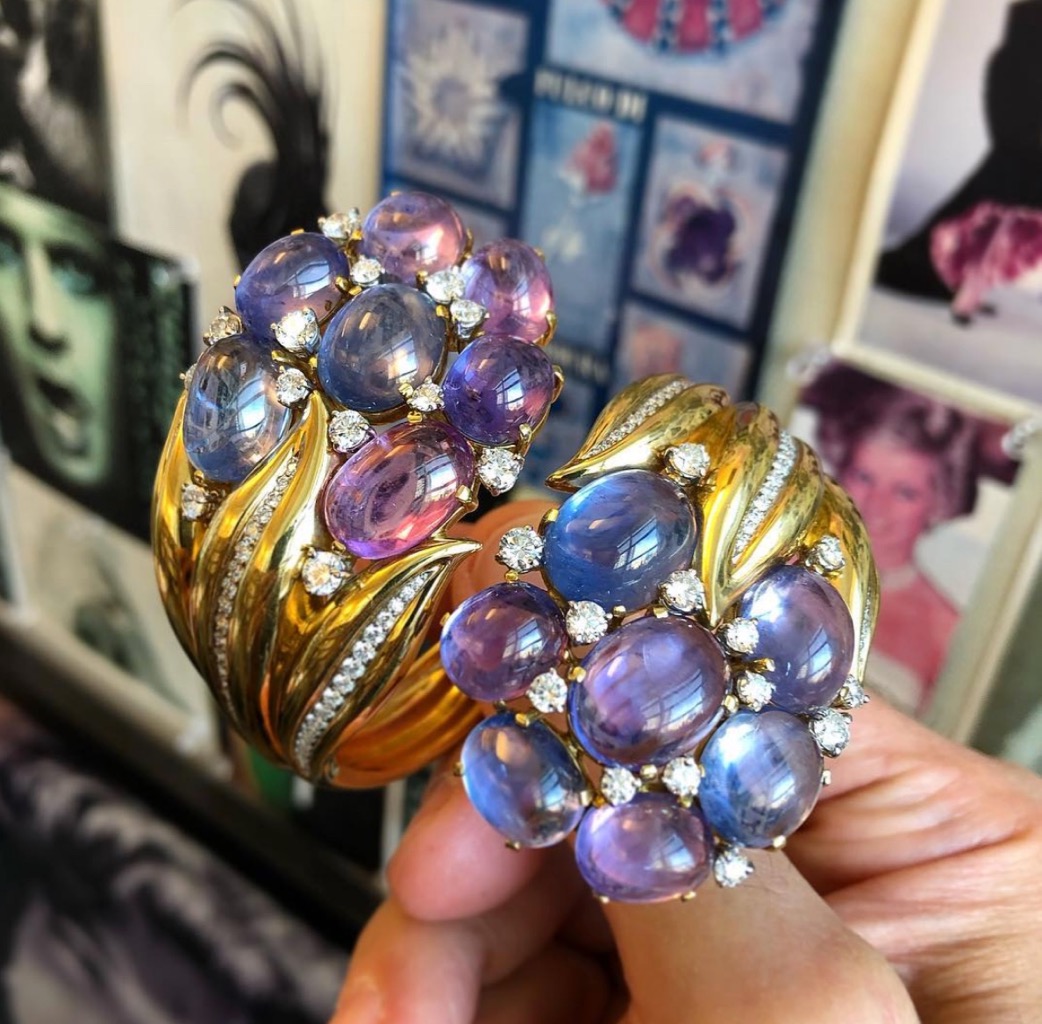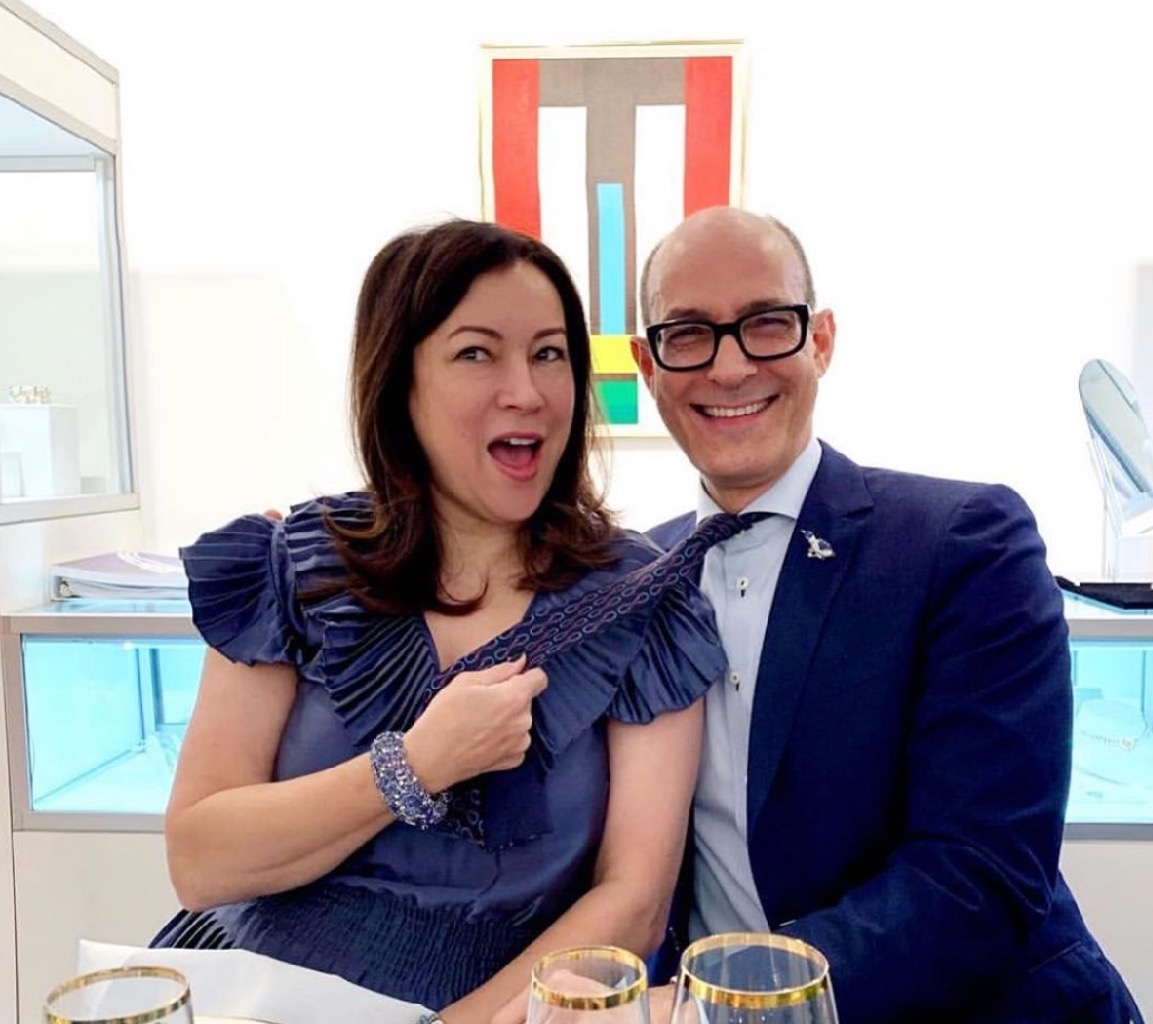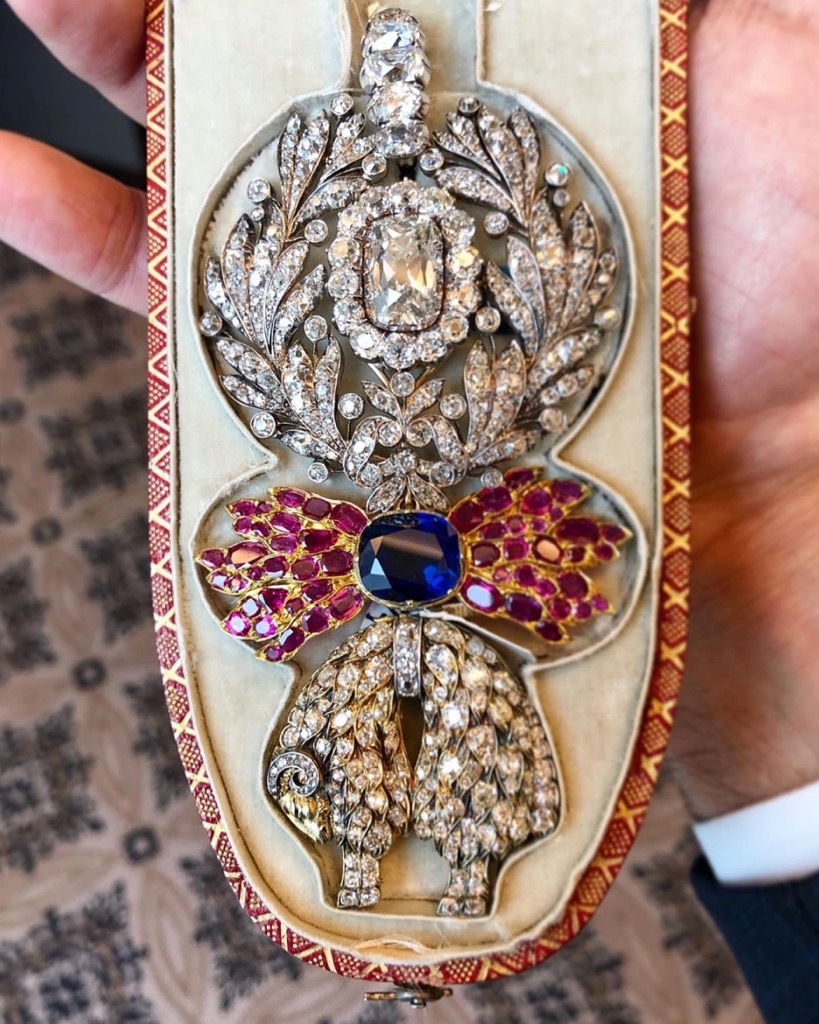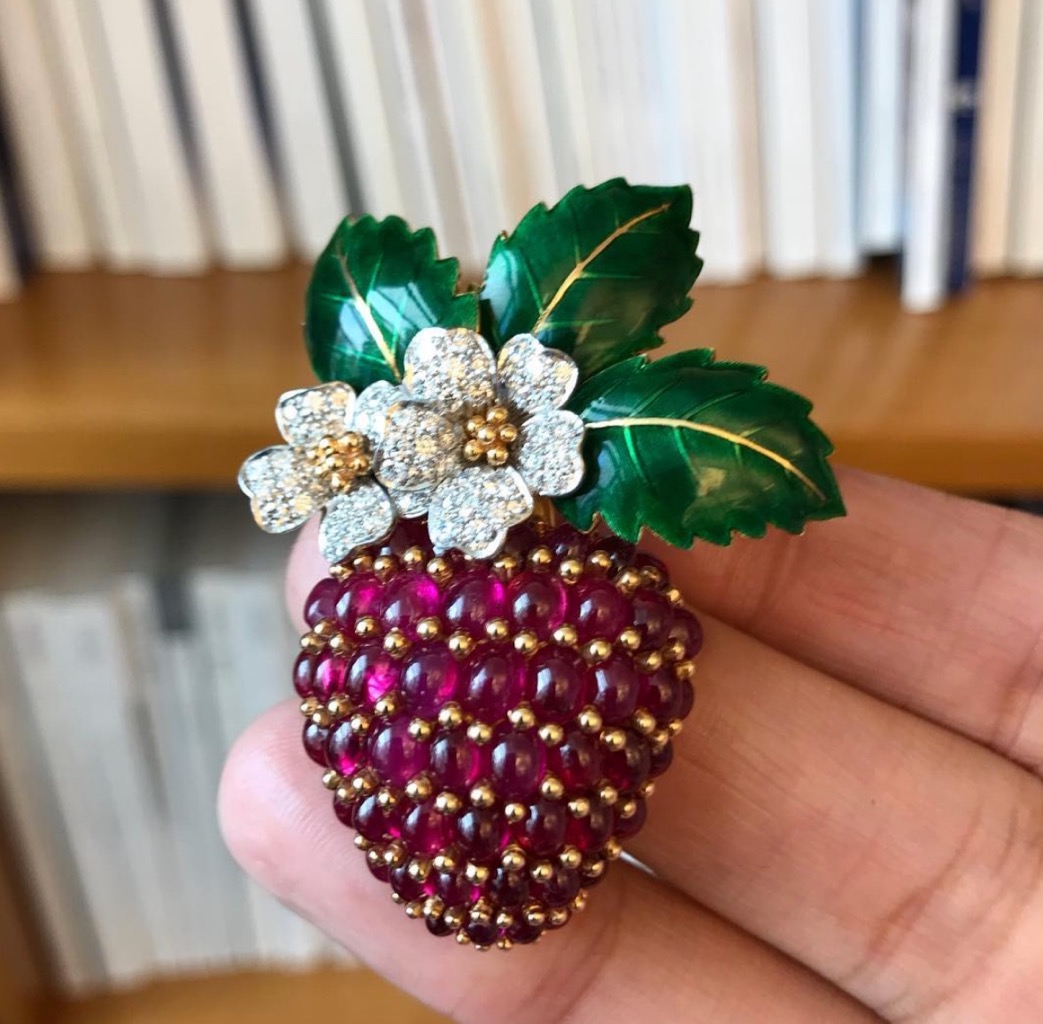
Frank Everett in front of his inspiration wall at Sotheby's New York. Photo courtesy
Jewelry News
Jewelry Influencer: Frank Everett of Sotheby’s
Get to know the jewelry expert behind the beloved Instagram and Frank’s Files
There is no more glamorous or adrenaline fueled way to buy jewelry than at auction. While traditional retail outlets struggle to engage clients, the big auction houses are providing all kinds of excitement in the auction rooms. They are also rolling out amazing events outside the action-packed sales.
In Bloom a selling exhibition at Sotheby’s in New York featuring 75 designers and pieces dating from the 19th century to the present day is a perfect example of this kind of thinking outside the box. The show was co-curated by Carol Woolton from British Vogue and Frank Everett, Senior Vice President, Sales Director for Sotheby’s Jewelry department in New York.
In celebration of In Bloom that will be on display until May 24, 2019 at Sotheby’s in New York City, I sat down with Frank to find out all about his beloved Instagram feed, Frank’s Files video series and so much more. Read on for our interview.

Diamond and demantoid garnet floral 19th century brooch from the ‘In Bloom’ selling exhibition at Sotheby’s on Frank Everett’s lapel. Photo via Instagram @frankbeverett
The In Bloom selling exhibition you put together with Carol Woolton is fantastic. Tell me how you got the idea? Is it the first time you have done a selling exhibit like this?
It is the first time where we created a curated selling exhibition and I am sure we will do more in the future. The idea came when I was in London for our Shaune Leane sale in 2017. I had lunch with Carol and she gave me a copy of her book Floral Jewels: From the World’s Leading Designers. We hatched the idea on the spot. It took 2-years to execute.
One of the time consumers was finding a moment to do it on the calendar. Senior management was so supportive and decided it should be May this year with all the contemporary and Impressionist art and the grand opening of the Sotheby’s galleries that have been renovated. The rest of the time was spent finding the jewels for the exhibit. We realized we couldn’t cover all periods, all styles and all makers, but we tried to cover a lot. We also included any number of contemporary designers that you don’t usually see for sale at Sotheby’s.
I love watching your video series Frank’s Files on Sothebys.com – the way you walk through a collection as well as the new episodes you are producing with jewelry houses like David Webb. Can you give me little behind-the-scenes detail on these productions?
The first Frank’s Files was shot on an iPhone in 2015. It was about a Cartier Paris ‘Boule’ ring with ruby beads across the top, similar in style to one made for Daisy Fellowes in 1948. Another very early one was on the inspiration wall in my office. We got great feedback on them and that’s when we started upgrading the quality. Now there is a proper film crew, the lighting is better and there is a makeup person and stylist.
In addition to reviewing sales, we also have special guests on Frank’s Files. I like finding people that are going to bring a new perspective to the jewels and highlight the fashion component. Some of the guests I have had are the stylist and host of What Not To Wear Stacy London, actress Jennifer Tilly and Cameron Silver from Decades, the legendary vintage clothing boutique in Los Angeles.

“Hyacinth” cuff bracelet by Verdura in gold, diamonds and an exceptional collection of cabochon sapphires from the ‘In Bloom’ selling exhibition at Sotheby’s. Photo via Instagram @frankbeverett
Your Instagram @frankbeverett is one of the most beloved in the jewelry world. Tell me a little about how you make the selections for your feed.
It really is the pieces that I love. I don’t use it just to promote or sell. It is my taste or a piece I am in awe of. It is usually about a jewel with a great design more than a big stone, but sometimes I will put a mind-blowing gem on there as well. Instagram is a way for me to share these special things that come across my desk that I was desperate to see earlier in my career.
I take a lot of time to get the right picture. I can take as many as 30 or 40 or pictures to get the right one, but I usually just post once a day. I don’t use filters. I have great light from my north facing office. People come from all over the department to take photos in my office because it is so good.
I adore your inspiration wall that is often shown on Instagram. Tell me about it.
My office is a typical cubical that is covered with this soft fabric. When I would see pictures I like or receive invitations to events, I started pinning them on the wall then I realized I could cover the whole thing with jewels from a sale or an image from a magazine. Everything I put on the wall has meaning. For example, the first time I sat with Jennifer Tilley at a lunch and we were photographed, I put that up on the wall. It is about authenticity. There are a lot of the great jewelry collectors up on the wall such Babe Paley and Daisy Fellowes.

Jennifer Tilly with Frank Everett at a lunch at Sotheby’s in Los Angeles. Photo via Instagram @frankbeverett
Let’s walk your love of jewelry back to the beginning. When did it start?
I have loved jewelry since childhood, seeing great pieces on family members. My mother’s side of the family were Eastern European Jews and lived in New York City. I would see my family in those mid-century looks like what the women wear on The Marvelous Mrs. Maisel. I grew up in rural Pennsylvania and my father’s side of the family was super Waspy and had great jewelry that was more traditional. I had an aunt who had a 9-carat emerald-cut diamond. I was mesmerized by it.
After college I spent some time in San Francisco working in the burgeoning food scene, then I decided to change careers when I was almost 40-years old to jewelry that I had loved for so long. I literally started behind the counter at Bulgari then I went to Tiffany and had managerial positions in Philadelphia, Miami and Los Angeles. Then I worked at Harry Winston in Miami.
I landed at Sotheby’s in 2013 after a recruiter called me and asked if I knew anyone for the job. When he described the position, working with multiple brands in multiple markets, I realized it was something I would love to do.
Your knowledge and expertise about jewelry history is so comprehensive. How did you gain this type of knowledge and experience? I feel like it is not taught in schools.
I was reading jewelry books long before I was in the jewelry business. The first one was Leslie Field’s 1987 publication The Queen’s Jewels: The Personal Collection of Elizabeth II. What that book had that I liked so much was it put the pieces in context, the story of when and why the Queen acquired a piece. I think that is such an interesting part of jewelry. Every brand I worked with, I read about and learned all the legends and lore. I really call on all that experience at Sotheby’s where it is a culture of storytelling and expertise.

The Golden Fleece from the Sotheby’s Bourbon Parma Sale Photo via Instagram @frankbeverett
Among all the incredible jewelry estates you have been involved with selling at Sotheby’s could you tell me about one of your favorites.
Of course, it was incredible to have the Bourbon Parma collection sold at Sotheby’s in Geneva last fall. For me in New York, it has to be Bunny Mellon in 2014 for many reasons—my history with Tiffany being a Schlumberger lover and being able to handle the jewels before they went to the Virginia Museum of Fine Arts. I can’t think that anything like that will ever happen to me again.
Tell me about that part of the job at Sotheby’s working with estates outside the auction room setting.
In the case of Mrs. Mellon, the jewels couldn’t go to the museum until the estate was settled. At Sotheby’s items sold for around $44 million. The rest had to be evaluated and housed for the estate before it could be handed over to the museum.
People with great collections acquire things at auction and they develop a relationship with Sotheby’s. It is the most highly trained and qualified place to get a valuation of jewels. People work with us, for example, when they are updating insurance appraisals. We also act as advisors to help people shape a collection.

Strawberry brooch by Oscar Heyman on Frank’s Instagram. Photo via Instagram @frankbeverett
Tell me a little bit about what your day-to-day is like working at Sotheby’s.
It is such a varied place and I love the fast pace. We are hardly ever between auctions and we are always traveling to the various markets for previews or sales. We also have a lot of different ways for people to buy jewelry today. Prices start at around $3,000 and then the sky is the limit. We sell online and in the auction room. The Geneva sales have the most old school feeling. People fly into the city to buy and there are a lot of paddles in the air.
How should someone approach Sotheby’s if they are interested in selling their jewels?
The first thing is to contact one of us at Sotheby’s. You can send an email with a photo. We can give you a quick estimate over the phone. You can drop in to a Sotheby’s office. We also make house calls if people would prefer not to travel with their jewels. We go to bank vaults. We also fly to see certain collections. We all try to make it work.
Related Stories:
Bunny Mellon’s Schlumberger Goes On Display
Jewelry History Owes A Lot to Cecil Beaton
A Look At Jayne Wrightsman’s Jewelry
Get a gem in your mailbox SIGN UP FOR THE ADVENTURINE NEWSLETTER




